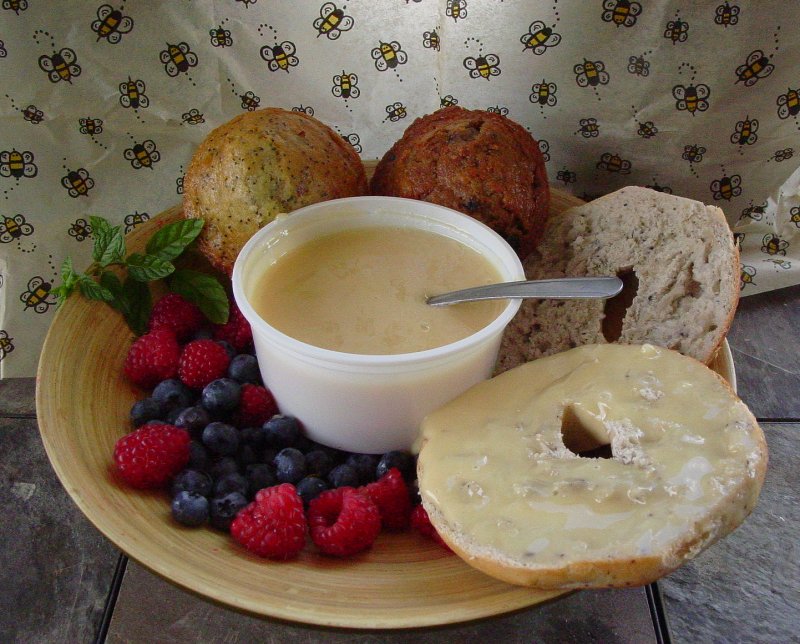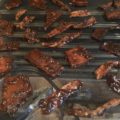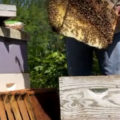What is creamed honey? Often called spun honey, or whipped honey (there really shouldn’t be any air in your creamed honey,) all seem to be interchangeable terms to describe the same thing. It’s creamy texture makes it more versatile to use since it can be used like a spread. If you spread it on a sandwich, it will not squish or drip out like honey might. I keep some in the fridge to make it tighter (like a cream cheese) and some in the cabinet to be more spreadable.
Creamed honey is simply the controlled crystallization of regular, liquid honey. By controlling it, the crystals are very fine and smooth vs. the grittiness of honey that was left to granulate in the jar in your pantry. The smaller the crystals, the better the creamed honey. A good creamed honey should be smooth like velvet on your tongue. Making creamed honey is a pretty simple process, but you can make it above average by being mindful of the science behind it.
Two main things we need for the best control is a good starter (or seed), and a 57° F environment in which to let it set. Following are the basic steps to making your own creamed honey.
- Source your starter. You can buy a starter from your bee supply, but why? I have never done this. You could also buy a small jar of creamed honey from the store, or even better, a beekeeper. The idea is to get a “seed” that will provide the crystallization (or template) that your bulk honey will follow. After you make your first batch you can save some of your creamed honey to add to your next batch. I read somewhere that you do not want to use honey that has already granulated, but that is just what I use to make my creamed honey, and with great success! I warm up this granulated honey… but only a little! Just enough to put into a blender or food processor to whip the heck out of it! When that honey reaches the desired creaminess, you have a good starter. Taste it, and feel the texture on your tongue. It should be immediately palatable.
- Prepare your bulk honey. There are varying points of view on this one. Some recipes suggest heating the honey to 140 degrees, then cooling it down quickly (in the refrigerator or a deep freeze). This supposedly makes it so your creamed honey will not ferment, but of course, the honey will lose some of its medicinal properties when heated to this temperature. Again, I myself like to use my honey that has already granulated. I take this honey, and heat it up just enough (stirring often) to turn the granulated honey back to a liquid. A nice slow way is to take it to 80-83F over a couple days. If you have heated your honey, you then need to cool it back down to room temperature as quickly as possible. I put mine in a 5-gal bucket and put it in my deep freeze. I check it with a candy thermometer until it’s back down to room temperature (about 70° F), It does not take long if you haven’t overheated it.
- Mix your starter into the bulk honey. When you have your honey back to room temperature, blend in the starter at a ratio of about 10 parts liquid honey to 1 part starter, and just know that this measurement does not have to be exact. Just mix until the starter is evenly distributed throughout your bulk honey.
- Add flavorings. Completely optional. Flavoring your honey is only limited by your imagination. You can buy flavorings, try extracts, or get creative. Think jalapeno, cinnamon, nutmeg, blueberry, and more. Add these in before you bottle your creamed honey to let it set. A friend of mine makes a stellar cayenne creamed honey and the spice is perfect.
- Let the crystallization begin. I do my cooling in bulk to a point… then, put into their final containers to finish. To start, I use these plastic wide mouthed containers, like a spreadable butter container, but taller and narrower. I don’t know where they came from, but they’re perfect. The idea is to let the starter crystallize the bulk honey into the creamy consistency of your starter (or seed). Having a 57° F environment optimizes this process. It’s slows (and controls) the speed at which it cools. This is desired to crystallize it to a consistency that doesn’t as easily thin out when sitting at room temperature. I rigged up a little dorm room fridge that was plugged into a temperature control that I could set. This ensured the proper temperature and it did give me a good set. If you don’t want to go through the hassle, put it in the coolest place you know (but not the fridge) during the crystallization process. This is where your honey should set until you use it, or sell it.
- Bottle it up. Bottle into your preferred containers. A container with a wide-mouth is advised here, so that it can be scooped out with a knife or spoon later. Once in the final containers, air will rise to the top. Leave it, so that the surface looks untouched to a customer you might sell it to. When the crystallization is set, you will already have it in the proper containers.
- Storage. If you have a room that maintains a temperature of around 57° F, this is where to store your honey. If it needs to, it will continue to crystallize, but more important, you can keep it firmer during storage until you take it to the market, or wherever it’s headed.
If you heat creamed honey, it will loosen. If you put in the fridge, it will tighten. There’s no wrong way. Store it the way you like it.





Hello Jason. I’m a new beekeeper and I’ve made creamed honey three times from a starter that I liked very much. The starter was velvety smooth. Each batch, however, came out significantly grittier than the starter, although nowhere near as gritty as regular granulized honey. Can you make some suggestions so that I can reproduce the smooth, velvety texture of my starter? Thank you very much.
Hi Jose. Sorry for my late reply. A couple things… first, think of your starter as a “template” of the crystal size. I make sure it is perfect… I’ll put it in a food processor and get it as velvety as I like. When this is added as the “seed” to the larger batch of liquified honey, the “starter” or “seed” is used as the template for the crystallization that will occur. Beyond this, the temperature during the crystallization process is key. You want to SLOW the speed by keeping it around 60F or so. Not as cool as fridge temps… and not as warm as room temperature. This should help. Also, keep in mind that when it is done… warmth will tend to liquefy your honey, and cold will set it firmer. If you are able, opt to keep it in the temps that you used during crystallization. This will keep it in the preferred state longer.